I am trying to use Gekko to optimize (dis)charging of a battery energy storage system. Electricity prices per hour EP, energy production from solar panels PV, and energy demand Dem are considered over the entire horizon (0-24h) to minize total costs TC. Arbitrage should take place as the battery is (dis)charged (Pbat_ch & Pbat_dis) to/from the grid (Pgrid_in & Pgrid_out) at the optimal moments.
As opposed to most of the examples online, the problem is not formulated as a state-space model, but mostly relies on exogenous data for price, consumption and production. 3 specific issues with reference to Gurobi are outlined below, the entire code which results in the following error, can be found at the bottom of this post.
Exception: @error: Inequality Definition
invalid inequalities: z > x < y
at0x0000016c6b214040>
STOPPING . . .
- The objective function is the sum of the costs resulting from buying/selling electricity to the grid over the entire horizon. I am used to Gurobi, which allows references to Manipulated Variables (
PowerGridOutandPowerGridIn = m.MV(...)) at specific timesteps in this manner ([t]).
m.Obj(sum(ElectricityPrice[t]*PowerGridOut[t] - ElectricityPrice[t]*PowerGridIn[t]) for t in range(25))
Is this also possible in Gekko, or should this summation be recast as an integral? Is the following code correct?
ElectricityPrice = m.Param([..])
.
.
.
TotalCosts = m.integral(ElectricityPrice*(PowerGridOut - PowerGridIn))
m.Obj(TotalCosts)
m.options.IMODE = 6
m.solve()
- Gurobi allows this formulation of the constraint to the change in state of charge of the battery:
m.addConstrs(SoC[t+1] == (SoC[t] - ((1/(DischargeEfficiency*BatteryCapacity)) * (PowerBattery
Discharge[t+1]) * Delta_t - ChargeEfficiency/BatteryCapacity * (PowerBatteryCharge[t+1]) * Delta_t)) for t in range(24))
Based on a question on stackoverflow regarding a similar problem, I have reformulated this in a continuous manner as:
m.Equation(SoC.dt() == SoC - 1/(DischargeEfficiency*BatteryCapacity) * Pbattdis - (ChargeEfficiency/BatteryCapacity) * Pbattch)
- The final key constraint should the power balance, where
Demand[t]&PV[t]are exogenous vectors, while the other variables arem.MV():
m.Equation(((Demand[t] + Pbat_ch + Pgrid_in) == (PV[t] + Pgrid_out + Pbat_dis)) for t in range(25))
Unfortunately, all of this has not worked so far. I would highly appreciate it if someone could give me some hints. Ideally I would like to formulate both the objective function and constraints in discrete terms.
entire code
m = GEKKO()
# horizon
m.time = list(range(0,25))
# data vectors
EP = m.Param(list(Eprice))
Dem = m.Param(list(demand))
PV = m.Param(list(production))
# constants
bat_cap = 13.5
ch_eff = 0.94
dis_eff = 0.94
# manipulated variables
Pbat_ch = m.MV(lb=0, ub=4)
Pbat_ch.DCOST = 0
Pbat_ch.STATUS = 1
Pbat_dis = m.MV(lb=0, ub=4)
Pbat_dis.DCOST = 0
Pbat_dis.STATUS = 1
Pgrid_in = m.MV(lb=0, ub=3)
Pgrid_in.DCOST = 0
Pgrid_in.STATUS = 1
Pgrid_out = m.MV(lb=0, ub=3)
Pgrid_out.DCOST = 0
Pgrid_out.STATUS = 1
#State of Charge Battery
SoC = m.Var(value=0.5, lb=0.2, ub=1)
#Battery Balance
m.Equation(SoC.dt() == SoC - 1/(dis_eff*bat_cap) * Pbat_dis - (ch_eff/bat_cap) * Pbat_ch)
#Energy Balance
m.Equation(((Dem[t] + Pbat_ch + Pgrid_in) == (PV[t] + Pbat_dis + Pgrid_out)) for t in range(0,25))
#Objective
TC = m.Var()
m.Equation(TC == sum(EP[t]*(Pgrid_out-Pgrid_in) for t in range(0,25)))
m.Obj(TC)
m.options.IMODE=6
m.options.NODES=3
m.options.SOLVER=3
m.solve()
